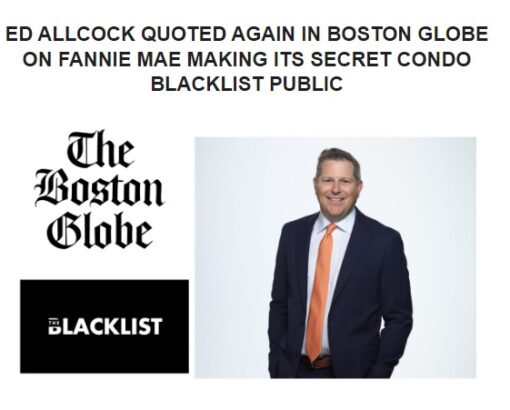
Fannie Mae to make its secret condo blacklist public
But the information will be available only to homeowners’ associations. Move follows Globe story on how unsuspecting buyers and sellers were left in the dark.
If a condo development is on the list, Fannie Mae will not buy a mortgage for that property.
By Jim Morrison, The Boston Globe
December 7, 2023
A little over a month after the Globe published a story about the Federal National Mortgage Association‘s condominium blacklist, the mortgage purchasing giant also known as “Fannie Mae” announced Thursday that it will make its secret “Condo Unavailable Projects and Phases Report” public. Previously, the information was available only to lenders, who were sent a spreadsheet with the header: “Fannie Mae Confidential and Proprietary — Subject to Non-Disclosure Obligations.”
A Fannie Mae spokesperson wrote in an email:
- “Fannie Mae will implement a web-based tool later in 2024 for condo homeowners’ associations that provides HOAs the ability to determine if loans secured by the project are ineligible for sale to Fannie Mae and to understand the reason why they may not meet one or more of our published requirements. (Fannie Mae’s website says it will make the information available in the third quarter.)
- More information on how HOAs can access and use the tool will be posted on our HOA-facing webpage closer to the time the tool is available for use.”
The Federal Home Loan Mortgage Corporation, popularly known as “Freddie Mac,” announced something very similar on Wednesday.
Fannie Mae and Freddie Mac buy home mortgages, package them, and sell them to investors, making it possible for borrowers in low-income brackets with lower credit scores and little saved for a down payment to get loans. The Federal Housing Finance Agency oversees it all.
Together, Fannie Mae and Freddie Mac support 70 percent of the mortgage market, according to the National Association of Realtors. If people want to buy properties that Fannie Mae won’t touch, they have to search elsewhere for a loan, which could ratchet up costs for some of the most vulnerable people in the housing market.
According to data obtained by the Globe, there were 1,770 developments in the United States on the list in May. By August, there were 2,001. As of October, there were 2,306. Thirty-seven of them were in Massachusetts, 1.6 percent of that list. Florida had the most (34.5 percent), followed by California (10.3 percent) and South Carolina (4.6 percent).
The other New England states had fewer blacklisted properties than Massachusetts:
Condominium developments present different risks to mortgage lenders than single-family homes. If a development includes a commercial component, not enough of the units are owner-occupied, the development is involved in litigation, or there are a lot of unit owners in arrears on fees, Fannie Mae may add it to the list.
Attorney Ed Allcock of Allcock Marcus said he is glad that Fannie Mae and Freddie Mac are becoming more transparent.
“I am glad that both Fannie and Freddie are now directly providing the same exact service that Allcock & Marcus has been providing to homeowners all over the country since we learned of and obtained the blacklist,” he said.
“I would hope that they would make the list generally available to the public, but this is a start. I am also hopeful that the implementation of an appeal process would allow for easier interaction between the federal government and condominiums trying to understand why they are on the list and how they can get off.”
Jim Morrison can be reached at JamesAndrewMorrison@gmail.com.

